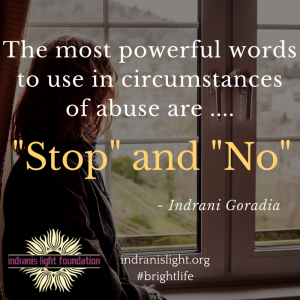 The most powerful words to use in circumstances of abuse are “Stop” and “No.” In our Live A Brighter Life workshops, we are teaching women in abusive situations HOW to say “No” to abuse. Here are some examples we teach:
The most powerful words to use in circumstances of abuse are “Stop” and “No.” In our Live A Brighter Life workshops, we are teaching women in abusive situations HOW to say “No” to abuse. Here are some examples we teach:
- You need to make yourself very clear. You may use other phrases such as “That’s not okay,” or, “That’s not appropriate,” or, “That’s enough,” or “It’s not okay for me.” But whatever you say, make it perfectly clear that you want the abuse to stop immediately.
- If the abuser is unclear about exactly what you want stopped, then make it clear by saying it exactly. For example, “Stop grabbing my arm,” or, “Stop blocking the doorway,” or “Do not hit me.”
- Putting up with physical or emotional abuse is a choice. If you choose not to accept it then a clear and specific “No” is the first step to removing yourself from the abusive situation.
Do you have a good friend or confidant who you can talk to? If so, here is a way you can practice saying “No” to your abuser….
- Ask your confidant if they can role play with you
- Now, practice clear statements, tone of voice, body language, etc.
- Ask for feedback. Where can you improve?
- Keep practicing. When you’re ready to speak your truth to your abuser, make sure your confidant is aware you will be acting upon your “Stop” and “No.”
(**NOTE: If you do not have a confidant to help you, practice these statements in the mirror at home).
Here are a few important things to remember while your preparing to speak your truth:
Go from a reactive approach to a proactive approach.
- Remember: anger can blind, fear can paralyze, and guilt can weaken.
- Don’t act with intense emotion but with clear purpose.
- If you need to, stop to collect your wits.
- You are allowed to take your time to recover and gain perspective
by saying things like, “Give me a minute,” or “ Let’s take a break,”
or “I need to think about it.” - Then ask yourself why you want to say, “No.”
- Crystallize your “yes” – what matters and your intention.
- The real action of standing up for yourself takes place inside
you before you say, “No.” - You have a right to protect what matters to you.
How are you feeling after reading this blog? Do you feel like to need more support around this? Just to let you know, we are teaching our FREE 6-week online Live A Brighter Life Workshop series this summer, starting June 30th. You can sign up HERE if you would like help from our ILF certified trainers.
With Love & Light,
Team ILF